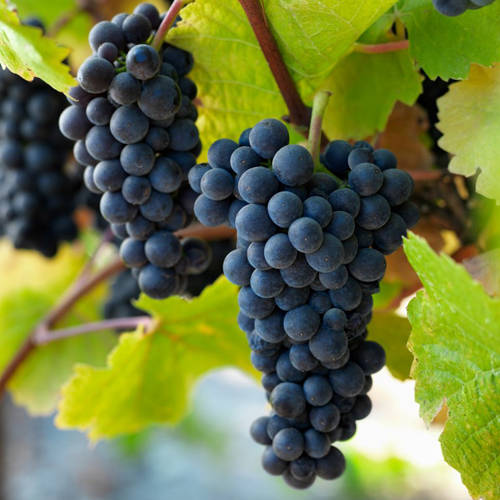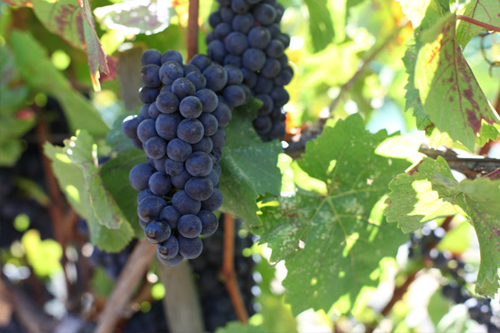Pinot noir grape variety
There is hardly a more conservative industry in the world than winemaking. The most expensive high-quality wines are made according to old recipes from classic grape varieties with a long history. One of these varieties is the magnificent Pinot noir, which is home to the famous French province of Burgundy. A related variety, Morillon noir, is mentioned in manuscripts of the 4th century, and in the 14th century, according to documentary evidence, Pinot noir itself was widely cultivated, being one of the main varieties for the production of local wines.

The name translates as “black cone”, apparently due to the visual similarity of small, stuffed bunches with pine cones.
The immediate parents of our hero, according to the scientists who have studied his DNA, are Traminer and Pinot Meunier. Pinot noir itself, according to similar genetic studies, is the progenitor of many other technical varieties of grapes, including such famous ones as Aligote and Chardonnay. In addition, it is susceptible to frequent mutations, in connection with which many clones have been born with specific qualities that distinguish them from the parent variety.
Currently, Pinot noir is widely cultivated both in its native France and in many other countries with a developed wine industry - Italy, Germany, Switzerland, Austria, USA, Japan, New Zealand, Chile and Argentina. It differs not in the highest yield, average resistance to fungal diseases, but rather high frost resistance and invariably high technological characteristics of ripe grapes.

Agrobiological characteristics
The bushes are medium-sized. The crown of the shoots and the first leaves are yellowish-green in color, but have a wine-red tint of the crown apex and the edges of the leaves. The leaves are medium-sized, rounded, three- or five-lobed (the middle lobe is wide), curved in the form of a funnel with a corrugated or finely bubbly surface. The upper lateral notches are open, shallow V-shaped, or deep lyre-shaped, the lower ones are open, barely outlined, or absent. The petiole notch is open with parallel sides and a rounded bottom. The denticles along the edge of the leaf blade are triangular with convex sides and rounded apices. Pubescence on the underside of the leaf is weak, cobweb-bristly. The flowers of the grapes are bisexual, perfectly pollinated with their pollen, the variety is prone to pea only in unfavorable years for flowering.
Pinot noir bunches are small, with an average size of 10 × 7 cm and weighing 70-120 grams. Cylindrical in shape, sometimes cylindrical-conical, high density. The stem of the comb is strong, lignified, about 4 cm long, the stems of the berries are short with a firm attachment to the bunch. The berries are medium in size, round, with a diameter of about 15 mm and an average weight of 1.3-1.5 grams. They can deform against each other due to the tight fit in the hand. The pulp is juicy, tender consistency. The taste is sweet, harmonious, without bright varietal shades. Uncolored juice. The skin is thin, medium strength, dark blue, covered with a gray waxy bloom. Seeds are present in the amount of 2-3 pieces, easily separated from the pulp. Berries are resistant to cracking, but susceptible to gray mold, especially in wet weather.

The harvest is intended to be processed into high quality wines. In its home country, along with Chardonnay and Pinot Meunier, Pinot noir is one of the three most popular varieties for the production of classic champagne. A distinctive feature of this grape is the ability to produce from it both red and pink, and even white drinks. The secret lies in the fact that the juice of the berries is colorless, while the dyes are in the skin. The color of the future drink depends on how quickly the peel is separated from the wort.The taste and bouquet of the finished wine can be very diverse, because the variety is very susceptible to both the differences in the soil on which it grows and the specifics of climatic conditions. Therefore, wines from different regions can have completely unique properties and be different from each other.
The variety is mid-season. The growing season of Pinot noir from budding to full maturity is 140-150 days. This requires the sum of active temperatures of 2700-2800 ° C. The grapes work best in years with warm dry autumn. The yield is low, about 50-60 kg / ha. The best growers are able to achieve a productivity of 100 kg / ha. Increased frost resistance: -24 -25 ° С. The percentage of fruitful shoots is 60-90%. The average number of clusters per fruitful shoot is 1.5-1.8, per developed one - 0.9. The sugar content of the grape must is 21-22 grams / 100ml, the acidity is 7-8 grams / l. In the total mass of the bunch, juice is 75%, peel and seeds - 20%, combs - 5%.

Agrotechnical features
Like most classic European varieties, Pinot Noir is quite demanding and whimsical, answering, however, to the care of the delicious quality of the wine obtained from it. Even the composition of the soil and the terrain are important for him. Our hero does not really like flat places and sweltering heat, while he succeeds especially well in regions with a moderately cool climate, preferring gentle slopes with weakly calcareous soils. In the south, the grape harvest ripens quickly, but does not acquire all its inherent characteristics of taste and aroma. Planting Pinot noir in lowlands, as well as in regions with an extremely cold and damp climate, will also be unsuccessful.
The variety is moderately resistant to diseases such as mildew and powdery mildew, but susceptible to gray mold. Therefore, it requires preventive treatments for the first two diseases, and a careful fight against the manifestations of the latter. It is not resistant to phylloxera, which is why in the regions of its distribution it reproduces exclusively in the grafted culture. Recommended rootstocks - Riparia x Rupestris 101-14, Berlandieri x Riparia Kober 5BB, Berlandieri x Riparia CO4. Due to the high density of bunches, the grape harvest can be affected by the bunch roll, and therefore requires insecticide treatment.
In addition, Pinot noir is characterized by early awakening of the eyes in spring, which can cause them to fall under recurrent frosts. In the event of the death of the main eyes, replacement buds awaken, however, due to their low fertility, there is no need to count on a high yield of a vineyard affected by frost. Certain difficulties can also arise due to the susceptibility of the variety to chlorosis.
The choice of the formation of bushes and their sizes depends on the fertility of the soil, the availability of moisture, the general favorable climate. This variety of grapes is very plastic, due to which, with varying degrees of productivity, it can grow in the form of small bushes, and in powerful formations with a large supply of perennial wood. Depending on this, the optimal load on the bush with shoots is also calculated. The pruning length is usually chosen to be medium, shortening the fruit arrows to 6-9 eyes.
Harvesting times for Pinot Noir may vary depending on the planned processing of the grapes. In the case of making red wine, it is better to leave the bunches longer on the bushes so that they acquire the maximum conditions for sugar accumulation and saturation of the bouquet and taste. When processing the "white" method, as well as for the production of champagne wine materials, an earlier harvest is practiced upon reaching a sugar content of 18-20%, in order to preserve the lightness inherent in white wines.
With all these conditions and necessary operations fulfilled, you can hope that the drink obtained from your grapes will at least a little bit resemble the famous Burgundy wines.And even if winemakers from France claim that this is impossible, there is no need to despair, because in Burgundy itself our hero does not have the same characteristics. As the French themselves say, wine from this variety differs from vineyard to vineyard. But no matter how complex and varied the compositions of its bouquet, the overall assessment of Pinot Noir wines always remains at its best.








